
The Copycats - Star Trek TOS
Prop Replica Reference Guide
Star Fleet Fabrications
This was a Massachusetts based husband and wife company that started out advertising in the Star Trek Welcommittee publications that were mailed out from convention attendance lists, dating back as far as 1973. It is also corroborated that they were selling replicas from that date at early east coast conventions in their area which, makes them the first known TOS prop replica maker (see the catalog section). Towards the end of their run they also advertised in Starlog magazine from the late 1970's to 1980. A very early pioneer in the hobby.
Years active: 1973-1980
Items Sold
Communicator: 265 units produced
Phaser II: 265 units produced
Science/Medical/Geological tricorder: 35 combined units produced
Data board: 20 units produced
Equipment belt: unknown
All these products are rare.
The Communicator was sold in two versions. Made from a soft finish haircell type of plastic, possibly ABS. Included machined aluminum parts such as moiré bezel ring with “hypno” style pattern, control plate, and midplate. Control knobs were plastic T-jet hubs. Grid was hand formed thin perforated brass, and hand soldered to brass wire.
It was not a very authentic looking unit but does have a certain charm to it. Large amounts of glue and solder were used in the process of its assembly. It's a very fragile piece as over time the glue and solder degraded and many of these fell apart causing their owners to discard them. This particular communicator replica should NEVER be “flipped” open due to its fragile nature and would undoubtedly get damaged. Must be handled and treated carefully.
Version 1. Functional unit had incandescent light bulbs as indicator lights which sat under colored cabochons. When grid was opened halfway a continuous “bird chirp” style sound is started and the middle of the three indicator lights blinked in tandem with the chirping sound. Once the grid was further opened and stopped, middle light went off along with the chirping sound, and the lights on either side of the center were activated and stayed on steady until grid was closed. There were variations. Early units did not have washers under the cabochons.
Version 2. A non-functional unit without electronics was also sold.
Communicator
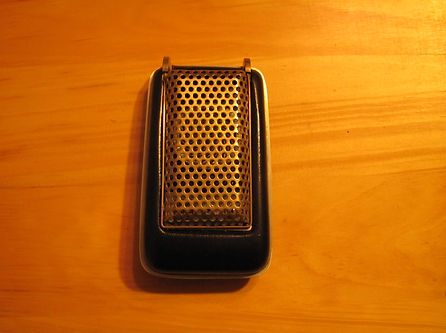
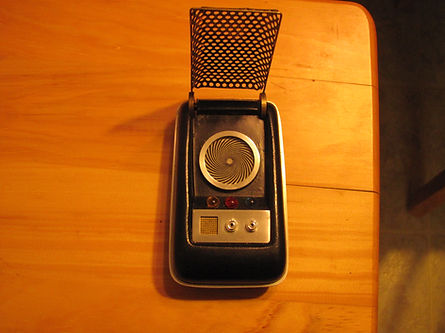
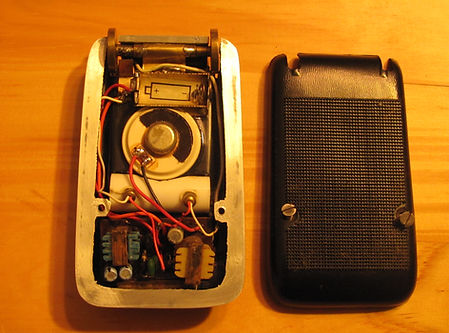


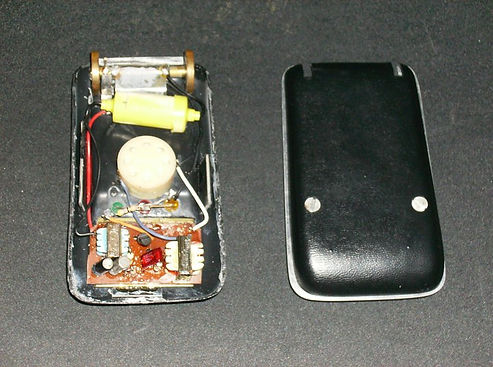
Last run unit with LEDs and different battery holder.
Phasers
These units were the first ever offered commercially through mail order and local convention sales. They were made of a fiberglass resin material with a primative aluminum style nozzle. Trigger was a hardware screwcap. Thumbwheel on hand unit was either ribbed or smooth aluminum and sometimes made of plastic. Handle had aluminum tape strips added on early models and a painted red "trigger bar". Hand units had red, green, blue, and even a yellow cabochon for the indicator light. Rear knob was a guitar adjustment control knob. Side and rear fins painted silver. Hand unit was attached by Velcro and of course removable from the lower half of the unit. There were NO pistol models ever made with working electronics. According to some, for a very short time he offered a working hand unit with some sort of strobe light in it. There is reportedly only ONE unit known. Like others, the phasers did go through upgrades. Later units had a more authentic looking aluminum nozzle, the rear knob was updated with a more generic one, the trigger bar on the hand unit was no longer painted red, and the aluminum tape strips on the handle were omitted.
Version 1





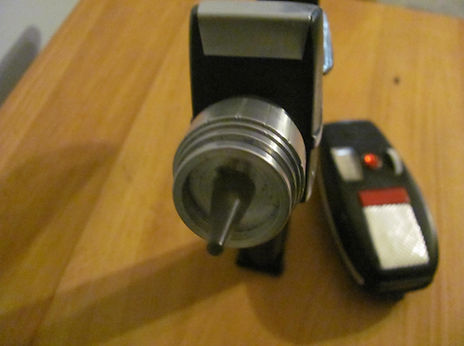

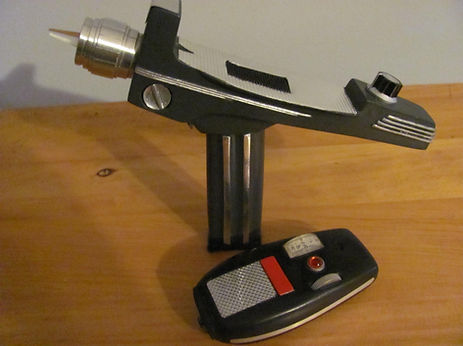

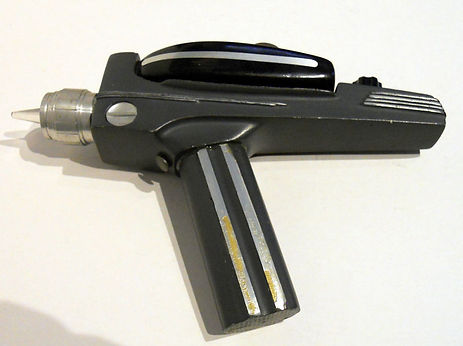


.Above - Hand unit. They advertised and sold for a very short time. As to the hand unit with a working "strobe" flash, only ONE is allegedly known to exist.
Version 2
Note the better nozzle and non guitar amp rear knob. Also, the hand unit trigger is now black and the aluminum tape strips are omitted from the pistol handle.
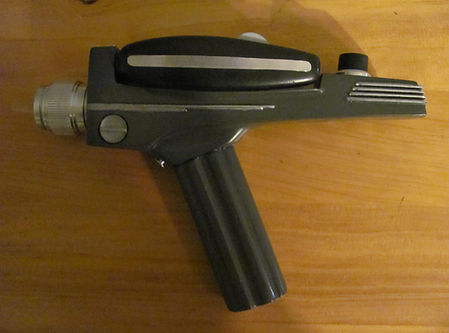









Note: both versions of the hand unit has prismatic tape above beam emitter.
Tricorder
Made of the same plastic and aluminum as their communicator, aluminum side panels, faceplate, midbar, and door handles, with leather strap. Unit is considerably smaller than other replicas and noticeably so. Much accuracy is lacking.
There are 3 known versions that were made by this company.
Science: With light up faceplate lights, green or blue screen with grid design, flashing light in the screen, cabochons, with beeping analog sound. Early units had an aluminum strip glued to the front of the hood so when closed, it would simulate the midbar.
Medical/Geological: Screen has reproduction “sickbay” transparency with working lit “heartbeat indicator” cabochon. Power supplied from 4 AAA batteries. Also had geological details behind the middle door, with flashing opaque white plastic window. They are extremely scarce. However, due to diminished size and accuracy issues, not that coveted.
They also made non functional units.




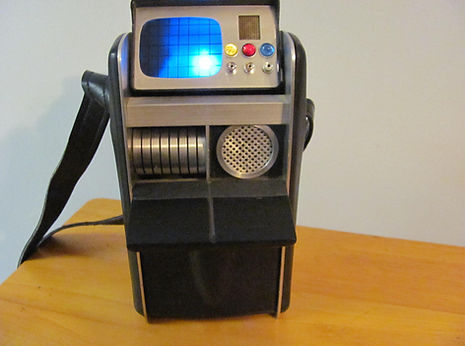
Right: green grid pattern screen used on some.

Another variation above. Perforated metal at the inside diameter of moiré disc, possibly for sound to escape on working models.





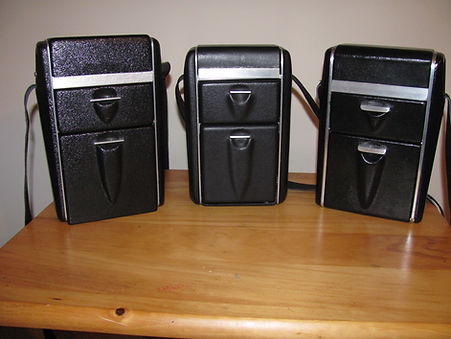
Above: Size comparison left to right: Starfleet Command, Star Fleet Fabrications, HMS.
Medical/Geological Tricorder


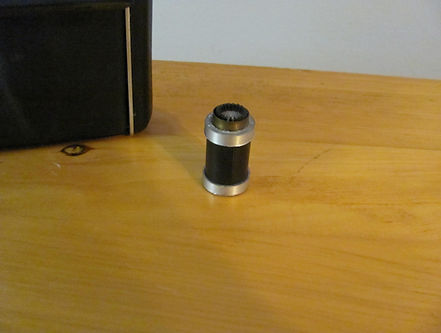
Removable static hand scanner.
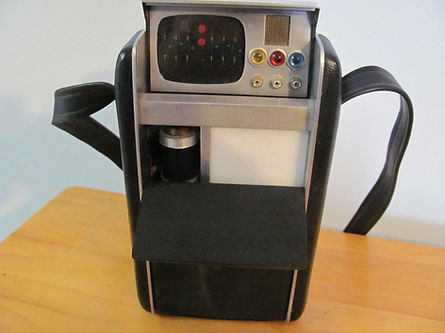
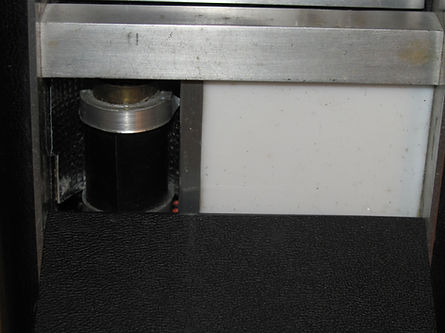

Light up/flashing cabochons and some units had pulsing "heartbeat indicator" in the illuminated screen. Flashing white window, along with sound effects, all in this one unit.
Equipment Belt
Made to order - leather with Velcro, and metal snap to attach phaser.
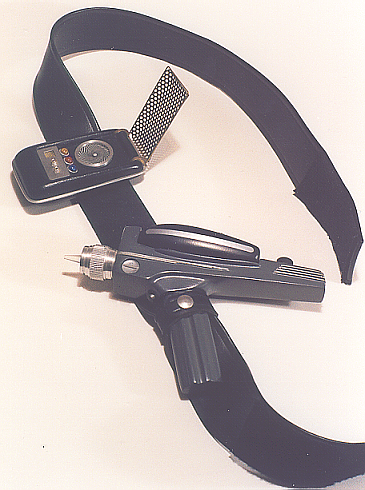
Data Board
Made of black acrylic, with three top dome lights. Once stylus was pressed on pad to write, dome lights were activated. Runs off a 9 volt battery.
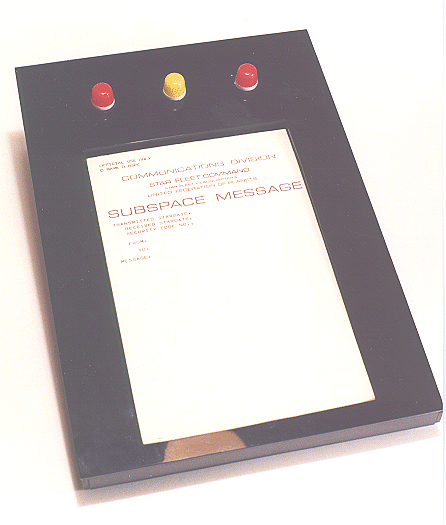
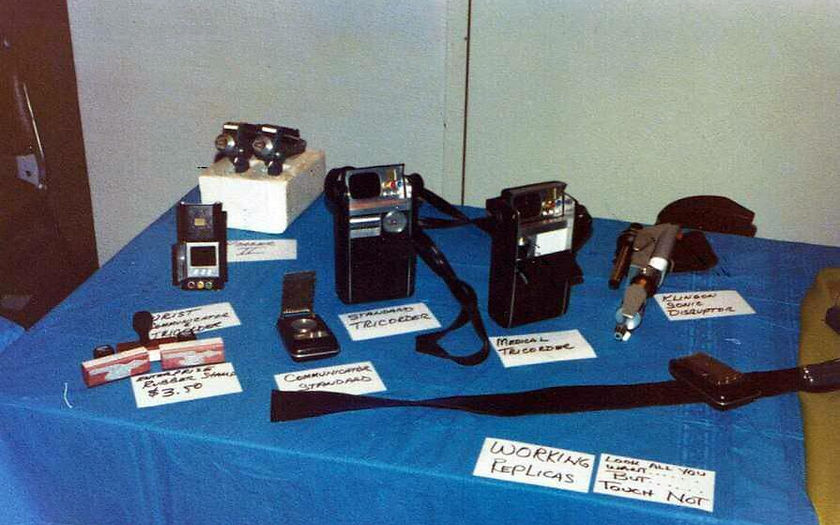
This is a picture of Star Fleet Fabrication's table at a local show in their area dating to 1977-1978. Photo courtesy of Al Hartman.